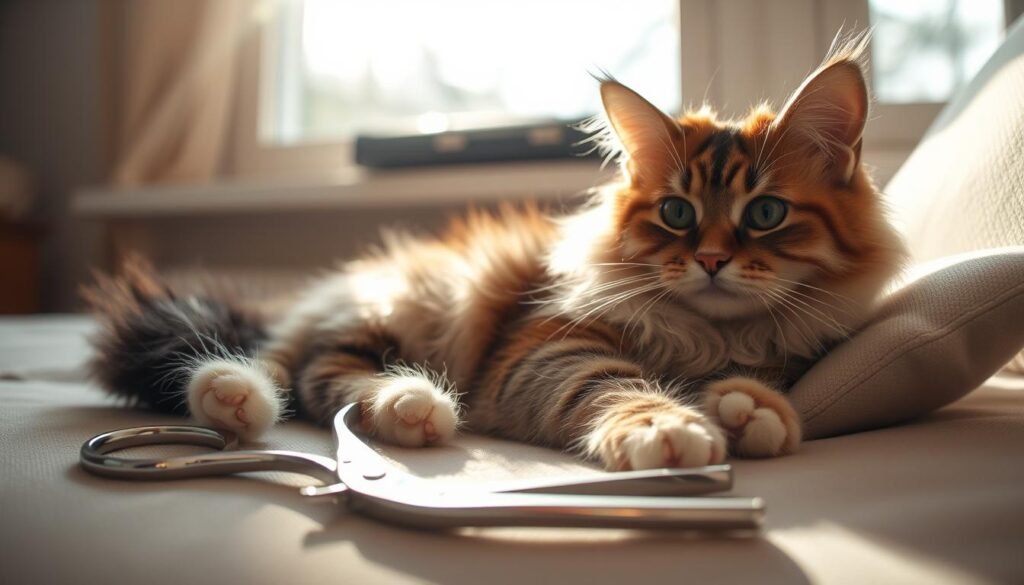Are your cat’s claws turning your furniture into a scratching post? Many pet owners struggle with this common issue. They wonder how often to cut cat nails to keep their homes in order. This guide will help you understand feline nail care, ensuring your pet’s comfort and your furniture’s safety.
Knowing the right time to trim your cat’s nails is key for their health. Regular nail care stops overgrowth, which can cause pain and health issues. By setting a regular nail care schedule, you’ll keep your cat happy and your home scratch-free.
In this detailed guide, we’ll cover everything about cat nail care. You’ll learn about your cat’s claw anatomy and how to trim them safely. We’ll discuss how often to cut cat nails, what affects trimming frequency, and how to make nail trimming stress-free for both you and your cat.
Key Takeaways
- Cat nails require trimming every 2-3 weeks on average
- Regular nail care prevents overgrowth and related health issues
- Trimming frequency varies based on individual cats and lifestyles
- Proper tools and technique are essential for safe nail trimming
- Consistent nail care benefits both cats and their owners
Understanding Cat Nail Anatomy and Function
Cats’ claws are fascinating structures that play a crucial role in their daily lives. Learning about cat nail anatomy helps you establish an effective cat claw maintenance routine. It also helps you understand the importance of proper cat nail length.
The Structure of Cat Claws
Cat claws are made of keratin, the same protein found in human nails. They’re retractable, allowing cats to keep them sharp and protected when not in use. Inside each claw is a quick, containing blood vessels and nerves.
Why Cats Need Their Nails
Nails serve multiple purposes for cats:
- Climbing and balance
- Self-defense
- Hunting and capturing prey
- Marking territory
- Stretching and exercising
Natural Nail Maintenance in Cats
Cats instinctively maintain their claws through scratching. This behavior sheds the outer layer of the nail, keeping it sharp and at a proper length. For indoor cats, a cat scratching post is essential for nail care. Outdoor cats use trees, logs, and other rough surfaces for this purpose.
Understanding these aspects of feline nail care helps you provide better support for your cat’s natural behaviors and health needs. Regular attention to your cat’s claws ensures they stay at a proper length and remain functional for all your cat’s activities.
The Importance of Regular Nail Trimming

Keeping your cat’s nails trimmed is key for their health and happiness. Trimming regularly stops nails from growing too long. This can cause many problems for your cat. It’s best to trim their nails every 10 to 14 days.
Long nails can make it hard for cats to pull them back. This can cause them to get stuck on carpets or furniture. It can also hurt them and make it hard for them to move.
Preventing overgrown nails is important for your cat’s health. Trimming their nails keeps them from scratching your furniture and skin. It also helps your cat move better and stand up straight.
“A well-maintained claw is a happy claw. Regular trimming keeps your cat comfortable and prevents potential health issues.”
Adding nail care to your cat’s routine is good for them. It lets you check for any health problems early. Remember, being consistent is important. Set a regular time to trim their nails to keep their paws healthy.
How Often to Cut Cat Nails
Finding the right time to trim your cat’s nails can be hard. Each cat is different, and they need different care. We’ll look at what affects your cat’s nail care schedule and give you some tips to keep their paws healthy.
Factors Affecting Trimming Frequency
Several things can change how often you need to trim your cat’s nails:
- Age: Younger cats may need more frequent trims
- Lifestyle: Indoor cats typically require more nail attention
- Activity level: Less active cats might need more frequent trimming
- Scratching habits: Cats who use scratching posts may need fewer trims
General Guidelines for Nail Trimming Schedules
Even though every cat is different, here’s a basic schedule for nail care:
| Cat Type | Recommended Trimming Frequency |
|---|---|
| Indoor cats | Every 2-3 weeks |
| Outdoor cats | Every 4-6 weeks |
| Senior cats | Every 3-4 weeks |
Signs That Your Cat’s Nails Need Trimming
Look out for these signs that your cat’s nails need a trim:
- Nails catching on fabric or carpet
- Clicking sounds when walking on hard surfaces
- Visible curling of the nails
- Difficulty retracting claws
Regularly checking your cat’s nails is crucial. By paying attention to their paw health, you can keep them comfortable and avoid problems with long nails.
Preparing for a Nail Trimming Session
Getting ready for a cat nail trimming session is key for a safe experience. A well-planned approach makes it stress-free for both you and your cat.
Choosing the Right Tools
Choosing the right tools is crucial for effective cat claw maintenance. Go for sharp, cat-specific nail clippers. Scissor-type or guillotine-style clippers are best for most cats.
Creating a Calm Environment
Set up a quiet, comfy space for nail trimming. Choose a time when your cat is relaxed, like after eating or playing. Dim lights and soft music can make it more soothing.
Acclimating Your Cat to Nail Handling
Start by gently massaging your cat’s paws during cuddle time. Use treats as rewards. This makes paw touching a positive experience for your cat.
| Step | Action | Duration |
|---|---|---|
| 1 | Paw massage | 1-2 minutes daily |
| 2 | Expose claws | 10-15 seconds per paw |
| 3 | Introduce clipper sound | 5-10 times per session |
| 4 | Touch claws with clipper | 2-3 seconds per claw |
Remember, patience is key in establishing a successful cat claw maintenance routine. With consistent practice, your cat will get more comfortable with nail trimming. This makes it easier to maintain safe cat nail cutting intervals.
Step-by-Step Guide to Trimming Cat Nails

Knowing when to cut your cat’s nails is key. But learning the right way to do it is just as important. This guide will show you how to trim your cat’s nails safely and without stress.
First, make a calm space. Pick a quiet room and sit your cat on your lap or a steady surface. Press their paw gently to show the nail. Look for the quick, the pink part with blood vessels and nerves.
Use sharp cat nail clippers to cut straight across the nail. Only trim the sharp tip, avoiding the quick. If you’re not sure, it’s safer to cut less to avoid hurting your cat.
- Extend the nail
- Identify the quick
- Cut perpendicular to the nail
- Trim only the sharp tip
- Reward your cat
If your cat’s nail starts bleeding, use styptic powder right away. It’s okay to do a few nails at once if your cat gets upset. Give them treats to make nail trimming a good thing.
By following this guide and trimming regularly, you’ll keep your cat happy and your furniture safe from scratches.
Special Considerations for Different Cat Types
https://www.youtube.com/watch?v=PlhHBwfsc2Q
Your cat’s lifestyle and health affect its nail care needs. A tailored cat claw maintenance routine is key for your cat’s comfort and health. Let’s look at how to adjust your feline nail care for different cat types.
Indoor vs. Outdoor Cats
Indoor cats need more frequent nail trims. Without outdoor surfaces, their claws grow faster. Trim indoor cat nails every 2-3 weeks.
Outdoor cats naturally wear down their claws. So, you might trim them monthly or as needed.
Senior Cats and Nail Care
As cats age, their nails get thicker and harder to shed. Senior cats need a gentler nail care routine. Check their claws weekly and trim every 3-4 weeks.
Be extra careful with older cats. Their paws might be more sensitive.
Cats with Mobility Issues
Cats with mobility problems or fewer legs have uneven nail wear. Their nail care needs special attention. Inspect their nails weekly and trim every 10-14 days.
This prevents overgrowth and discomfort.
Remember, every cat is different. Watch your pet’s behavior and nail condition to fine-tune your care. Regular checks and adjustments keep your cat’s paws healthy and comfortable, no matter their needs.
Potential Risks of Neglecting Nail Care
Not taking care of your cat’s nails can cause big problems. Long nails can curl back and hurt your cat’s paw pad. This makes it hard for them to walk. So, it’s very important to prevent cat nail overgrowth.
Long nails can also trap dirt and litter, leading to infections. These infections make your cat very uncomfortable. Checking your cat’s nails regularly can help avoid these issues and keep them healthy.
Ignoring your cat’s nails can also cause them to grow inward, leading to pain and infections. By keeping up with nail care, you can prevent these issues. Remember, taking care of your cat’s nails is key to their overall health.








I think cats should keep their nails long for self-defense. Are we compromising their safety by trimming them too often? Just a thought. 🤔
Just read the article, but isnt it unnatural to cut cat nails? Dont cats naturally wear them out by scratching and climbing?
I reckon, cats in the wild dont get mani-pedis! Why should indoor kitties? Arent we tampering with their natural instincts? Just a thought!
Well, wild cats dont face sofas, carpets, or humans. Adaptation to environment, mate!
Really, arent we over-managing our cats? I mean, they survived in the wild for centuries without manicures. Just a thought…
Interesting points, but isnt it more natural to let cats maintain their nails through scratching? Just a thought.
Interesting read, but isnt it a bit much to trim cat nails frequently? Arent they natural self-sharpeners? Just my two cents, guys.
Natural self-sharpening doesnt mean its unnecessary to trim. It can prevent potential injuries.
Really, arent we invading the cats personal space by cutting their nails? What if they prefer their nails long? Just a thought.
I get this guide, but arent we invading our feline friends natural instincts by trimming their nails too often? Just asking. 🤔